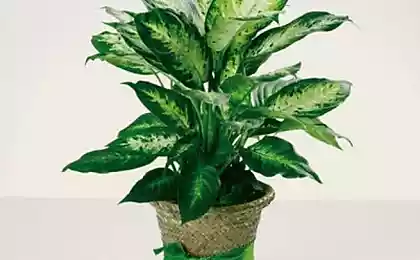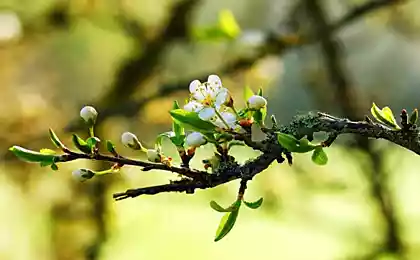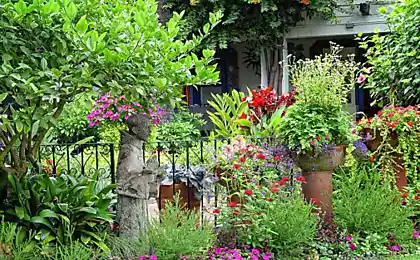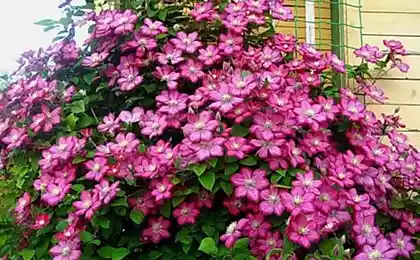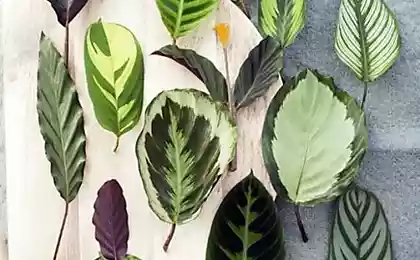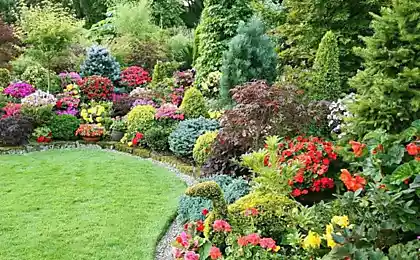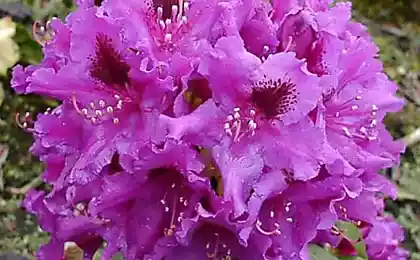495
The best ornamental shrubs for the garden: forsythia
Amazing plant: early spring branches of forsythia with all those Sunny yellow flowers, and only then — when they fall — there is a young foliage. This shrub is remarkable in the first place, namely its flowering.
The only thing that should definitely be considered when buying a plant: forsythia thermophilic, and for planting in cold regions are not suitable for all types — some even freeze slightly at the shelter in severe winters, and to see them in color is not possible.
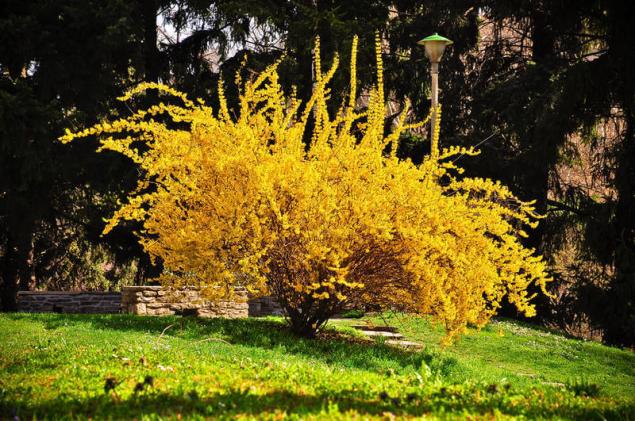
The garden is just waking up, but gold openwork blooming forsythia is a perennial shrub of the olive family. Forsythia is decorated with its flowering gardens from March to April. Her Golden-yellow four-leaf flowers, like bells, fluffy cloud enveloping a flexible, leafless stems. But oval, slightly toothed leaves appear later – after the end of the flowering period. Unique plant: first blossoms and then produces leaves and young shoots.
Forsythia is originally from East Asia. But the lovely Asian girl conquered Europe in the 18th century and now occupies a worthy place in the gardens of Central and southern European Russia. It attracts gardeners because of its uniqueness, and its bright bloom against the background of "naked" after the winter trees, truly results in admiration.
Reproduction description.
Asian Golden propagated in autumn, by cuttings or layering (weeping form), rarely by seeds. Layering is the most easiest way, because the pull-down branches of forsythia in contact with the ground, can take root on their own. But in order to propagate forsythia cuttings as you need, fall, drop its lower branches to the ground, just slice the bark in the place which will become the heel, clip the branches and sprinkle with the ground at 10-15 cm And in the spring, trim cuttings from the parent plant, and a year later a young Asian bloom.
To propagate it by cuttings: green or lignified. Green cuttings cut at the beginning of June, incubated in a solution of stimulants ("Kornevin" or "Appin"), then, perpetuate and Harbor film. By autumn the plant survives and are ready for the winter. Don't forget in the winter to sprinkle the soil with dry leaves or straw to a height of 15-20 cm.
Reproduction lignified cuttings is also not particularly difficult. In autumn, thick branches are cut into cuttings with a size of 15-18 cm, then digged them into the ground, buried 8-10 cm, so that the overhead part of the left kidney. Then posaditi thoroughly cover foliage. In addition, you can purchase ready seedlings of plants.
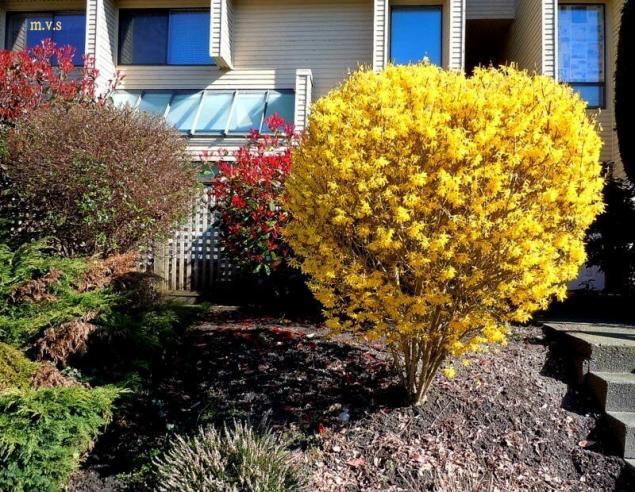
Planting forsythia
Seedlings of forsythia planted in the fall, selecting a Sunny windless places and considering the characteristics of each variety. However – it may feel good in partial shade, so it looks appropriate and under the Windows of a country house.
Golden Asian likes light and fertile soil. The perfect soil mix for it consists of humus, leaf soil and sand in the ratio: 1:1:2.
The pits for planting, make 60x60 cm and deepened by 70-80 cm, keeping the distance between them is 1-3 meters, depending on the size of the adult plant.
Fossa quarter-poured draining layer of gravel or broken bricks. Then gently place the seedling in the hole, and sprinkled his prepared soil mixture and watered abundantly.
The care of forsythia
Every fall, the forsythia bushes mulched leaves or straw, and a flexible hanging branch bends to the ground, fastened and carefully covered with spruce branches.
In the spring the mulch layer is removed, branches are released, and under the bushes put a thick layer of humus or manure (but not too close to the base of the stems) and fertilizers from the calculation of 70-80 g per sq. m.
During the growing season, the forsythia are watered. She better tolerate drought than excess of moisture, so needs watering only in the most arid months.
But the most important event in the care of forsythia – it annual pruning. Note that severely cut bushes bloom very bad, so the young shoots are cut just the top, and the decorative trim is cut to just heavily distracting from the overall composition stems.
After wintering dry branches of forsythia cut to healthy wood, and after flowering pruned a little less than half withered shoots.
With proper care forsythia will greet you every spring Golden clouds of bright yellow blossoms, and in autumn turn a garden into a beautiful tale, because its autumn foliage is unusually decorative.
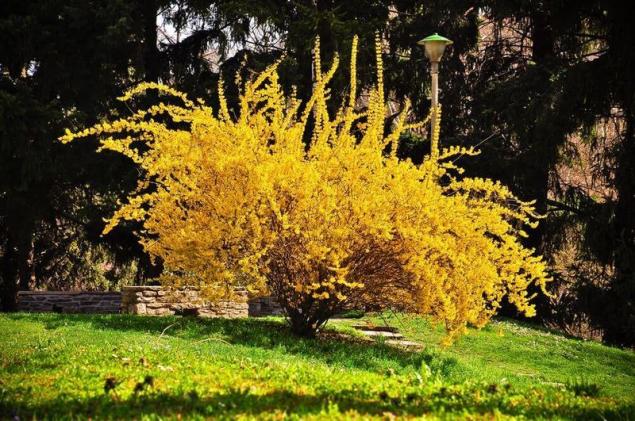
The types of description.
Forsythia has seven species and many varieties of similar biological characteristics.
For planting in gardens median strip Russia usually use the forsythia hanging down (pendulous), intermediate (hybrid) and ovate. To the warm climate of the southern regions perfectly adapted forsythia European and dark green. Consider the characteristics of each of these types.
Forsythia hanging down is a sprawling shrub up to 3 m with pendulous branches arcuate. Its bright Golden flowers with a diameter of 2-2.5 cm in racemes of 3-5 pieces (sometimes a single grow). Stems olive green heap grow simple oval leaves with scalloped edges and young growth trifoliate leaves.
In landscape design the forsythia hanging successfully used for decorating walls of houses, the positioning on the trellis. I will mention two of the most decorative forms of forsythia hanging: colorful and Fortune.
Hanging variegated forsythia blooms bright yellow-orange flowers. Has serrated dark green leaves sword-shaped, contoured bright yellow border. The landscape looks very decorative.
Ornamental shrub of the first two or three years, with erect branches, and then producing arcuate curved shoots. The flowers are orange-yellow in racemes 2-5 pieces and richly vsypayut Bush during flowering.
Forsythia hybrid (intermediate). As a result of successful experiments selectors, it turned out hardy and drought-resistant species of forsythia, which is called hybrid or intermediate. Her magnificent shrub up to 3.5 m, has a direct and drooping shoots, sprinkled with bright yellow flowers. Leaves ovate-lanceolate simple, rarely Ternate.
Forsythia ovate. Forsythia ovata – a graceful shrub to 2 m with shirokoraskidistaya crown. Her single bright yellow flowers of Golden mist cover the whole shrub. To replace the flowers come in long oval leaves, pointed to the apex.
Forsythia ovata blooms before other plants, but flowering a short 12 to 18 days. But it is very dressy fall with its orange, yellow and dark purple leaves fading perfectly decorate the garden.
Forsythia European. Thick elastic stems of forsythia European luxury form a hemisphere with a diameter up to 3 m and extend up to 1.5-2 m. flowers large bell-shaped flowers are bright lemon yellow. Her long-oval leaves (4 to 8 cm) have a delicate light green hue.
Are durable, one can live more than 70 years.
Also interesting: you Want exotic in the garden? Plant bamboo!
Drought-resistant garden plants: choosing the most beautiful varieties of
Forsythia dark green. This species of forsythia gets its name from its dark green color of the branches, reaching 3 m in height. Its bright lime flowers are collected in bundles of 3 PCs., rarely come singly. The leaves are simple, lanceolate, serrated in the upper part.
Forsythia dark green drought-tolerant and more thermophilic than other types of plants.published
Source: vk.com/bg.garden?w=wall-83256494_36827
The only thing that should definitely be considered when buying a plant: forsythia thermophilic, and for planting in cold regions are not suitable for all types — some even freeze slightly at the shelter in severe winters, and to see them in color is not possible.

The garden is just waking up, but gold openwork blooming forsythia is a perennial shrub of the olive family. Forsythia is decorated with its flowering gardens from March to April. Her Golden-yellow four-leaf flowers, like bells, fluffy cloud enveloping a flexible, leafless stems. But oval, slightly toothed leaves appear later – after the end of the flowering period. Unique plant: first blossoms and then produces leaves and young shoots.
Forsythia is originally from East Asia. But the lovely Asian girl conquered Europe in the 18th century and now occupies a worthy place in the gardens of Central and southern European Russia. It attracts gardeners because of its uniqueness, and its bright bloom against the background of "naked" after the winter trees, truly results in admiration.
Reproduction description.
Asian Golden propagated in autumn, by cuttings or layering (weeping form), rarely by seeds. Layering is the most easiest way, because the pull-down branches of forsythia in contact with the ground, can take root on their own. But in order to propagate forsythia cuttings as you need, fall, drop its lower branches to the ground, just slice the bark in the place which will become the heel, clip the branches and sprinkle with the ground at 10-15 cm And in the spring, trim cuttings from the parent plant, and a year later a young Asian bloom.
To propagate it by cuttings: green or lignified. Green cuttings cut at the beginning of June, incubated in a solution of stimulants ("Kornevin" or "Appin"), then, perpetuate and Harbor film. By autumn the plant survives and are ready for the winter. Don't forget in the winter to sprinkle the soil with dry leaves or straw to a height of 15-20 cm.
Reproduction lignified cuttings is also not particularly difficult. In autumn, thick branches are cut into cuttings with a size of 15-18 cm, then digged them into the ground, buried 8-10 cm, so that the overhead part of the left kidney. Then posaditi thoroughly cover foliage. In addition, you can purchase ready seedlings of plants.

Planting forsythia
Seedlings of forsythia planted in the fall, selecting a Sunny windless places and considering the characteristics of each variety. However – it may feel good in partial shade, so it looks appropriate and under the Windows of a country house.
Golden Asian likes light and fertile soil. The perfect soil mix for it consists of humus, leaf soil and sand in the ratio: 1:1:2.
The pits for planting, make 60x60 cm and deepened by 70-80 cm, keeping the distance between them is 1-3 meters, depending on the size of the adult plant.
Fossa quarter-poured draining layer of gravel or broken bricks. Then gently place the seedling in the hole, and sprinkled his prepared soil mixture and watered abundantly.
The care of forsythia
Every fall, the forsythia bushes mulched leaves or straw, and a flexible hanging branch bends to the ground, fastened and carefully covered with spruce branches.
In the spring the mulch layer is removed, branches are released, and under the bushes put a thick layer of humus or manure (but not too close to the base of the stems) and fertilizers from the calculation of 70-80 g per sq. m.
During the growing season, the forsythia are watered. She better tolerate drought than excess of moisture, so needs watering only in the most arid months.
But the most important event in the care of forsythia – it annual pruning. Note that severely cut bushes bloom very bad, so the young shoots are cut just the top, and the decorative trim is cut to just heavily distracting from the overall composition stems.
After wintering dry branches of forsythia cut to healthy wood, and after flowering pruned a little less than half withered shoots.
With proper care forsythia will greet you every spring Golden clouds of bright yellow blossoms, and in autumn turn a garden into a beautiful tale, because its autumn foliage is unusually decorative.

The types of description.
Forsythia has seven species and many varieties of similar biological characteristics.
For planting in gardens median strip Russia usually use the forsythia hanging down (pendulous), intermediate (hybrid) and ovate. To the warm climate of the southern regions perfectly adapted forsythia European and dark green. Consider the characteristics of each of these types.
Forsythia hanging down is a sprawling shrub up to 3 m with pendulous branches arcuate. Its bright Golden flowers with a diameter of 2-2.5 cm in racemes of 3-5 pieces (sometimes a single grow). Stems olive green heap grow simple oval leaves with scalloped edges and young growth trifoliate leaves.
In landscape design the forsythia hanging successfully used for decorating walls of houses, the positioning on the trellis. I will mention two of the most decorative forms of forsythia hanging: colorful and Fortune.
- Hanging variegated forsythia.
Hanging variegated forsythia blooms bright yellow-orange flowers. Has serrated dark green leaves sword-shaped, contoured bright yellow border. The landscape looks very decorative.
- Forsythia hanging Fortune.
Ornamental shrub of the first two or three years, with erect branches, and then producing arcuate curved shoots. The flowers are orange-yellow in racemes 2-5 pieces and richly vsypayut Bush during flowering.
Forsythia hybrid (intermediate). As a result of successful experiments selectors, it turned out hardy and drought-resistant species of forsythia, which is called hybrid or intermediate. Her magnificent shrub up to 3.5 m, has a direct and drooping shoots, sprinkled with bright yellow flowers. Leaves ovate-lanceolate simple, rarely Ternate.
Forsythia ovate. Forsythia ovata – a graceful shrub to 2 m with shirokoraskidistaya crown. Her single bright yellow flowers of Golden mist cover the whole shrub. To replace the flowers come in long oval leaves, pointed to the apex.
Forsythia ovata blooms before other plants, but flowering a short 12 to 18 days. But it is very dressy fall with its orange, yellow and dark purple leaves fading perfectly decorate the garden.
Forsythia European. Thick elastic stems of forsythia European luxury form a hemisphere with a diameter up to 3 m and extend up to 1.5-2 m. flowers large bell-shaped flowers are bright lemon yellow. Her long-oval leaves (4 to 8 cm) have a delicate light green hue.
Are durable, one can live more than 70 years.
Also interesting: you Want exotic in the garden? Plant bamboo!
Drought-resistant garden plants: choosing the most beautiful varieties of
Forsythia dark green. This species of forsythia gets its name from its dark green color of the branches, reaching 3 m in height. Its bright lime flowers are collected in bundles of 3 PCs., rarely come singly. The leaves are simple, lanceolate, serrated in the upper part.
Forsythia dark green drought-tolerant and more thermophilic than other types of plants.published
Source: vk.com/bg.garden?w=wall-83256494_36827





